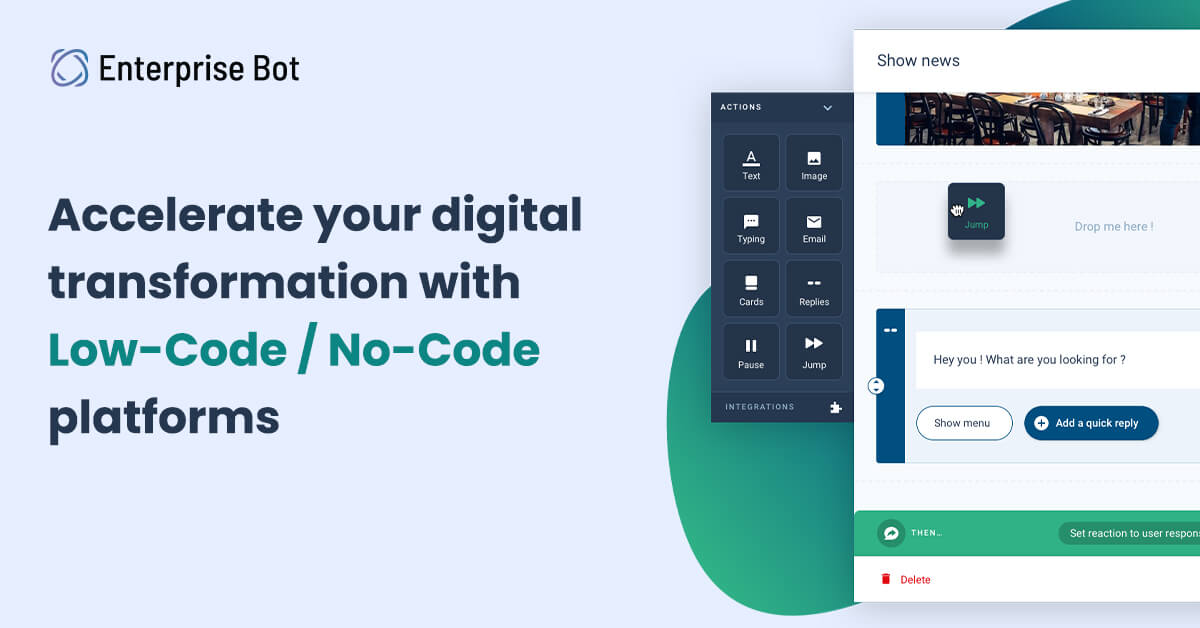Reshape your digital transformation strategy using Low-Code platforms

In today’s digital-first business landscape, speed and agility are the keys to thrive in the market and outpace the competition. Still, many organizations lack the right technologies and processes that can speed up their operations, ensure compliance & accuracy, and scale-up production. Leading enterprises have been leveraging low-code platforms to close major operational gaps in their existing business processes by digitizing manual, time-consuming spreadsheet works. Moreover, organizations worldwide have been focusing on API-level integrations while kicking off their automation journey to ensure seamless connectivity to their core business applications with advanced options like free flow and data sync.
Be it self-developing an app by a business user or reducing hand-coding for developers with processes automation, no-code / low-code platforms makes it simpler than ever. A low-code development not only eliminates the complexity of your application delivery, but also helps you achieve a record faster time-to-market. On the other hand, no-code development uses a visual interface that helps business users build apps with simple drag and drop. They don’t need any prior knowledge of coding.
Low-code and no-code, both the automation solutions offer critical benefits to present-day business and their enterprise-level adoption is growing day by day.
By 2023, every medium to large enterprise will have adopted a low-code application platform.
(Source: Gartner)
Why Is It Imperative for Enterprises to Embrace Hyperautomation?
Before automation moved to the bleeding edge as one of the core technological developments, most of the organizations were hesitant to implement it. Entrepreneurs dreaded change and employees were stressed over losing their jobs. Especially post-pandemic things have started to change drastically. As organizations encountered unprecedented challenges to continue operations and meet client expectations without hurting their bottom line, they realized the value an unified automation solution can bring into their business.
From high call volumes, to increased workloads, to remote operational challenges, to digital transactions, to meeting compliance – organizations faced a tough time to balance everything while ensuring quality. They understood the significance of being digitally adept and resilient for sustaining in such crisis situations.
Let’s take a look at the operational gaps that have been pressing points for most of the organizations:
Hand-coded Integrations:
Hand-coded integration is a complex and slow process that requires highly skilled resources. It consumes months before launch. Moreover, you need additional workforce to develop integration from scratch. Hiring and training these resources involve high costs and are also difficult to find. Companies still operating on hand-coded integrations experience time and budget overrun.
Post-Integration Maintenance & Management:
More than integration the difficulty lies with maintaining, managing and upgrading the applications throughout. It’s not at all cost-effective, moreover, resource-intensive. They get overburdened to keep the applications up-to-date with bug fixing, third-party API updates, infrastructure management, feature requests, compliance, and security audits.
Customization
One of the basic functionalities most of the low-code and no-code solution providers offer is it will eliminate the need for manual coding. However, when the reality hits, their business logic often fails to deliver the promised outcome while integrated into various business models. It only shows results for the pre-assigned number of use cases it has been programmed for.
In exceptional situations, for instance, when you abruptly need to scale the framework for a complex workflow, these platforms might turn out to be ineffective. Until you track down the correct configuration per the specific business logic all efforts may get counterproductive. In such cases, writing a bunch of codes is the most cost-efficient, simplest, and fastest solution.
Vendor Lock-In
A few organizations may decide to opt for an alternate solution that will not involve complex, time-consuming integration processes. They will simply pick an ‘all-in-one’ low-code platform. They expect that setting up a new system having all BPM functions will make the process seamless unlike integrating various applications. But, getting away with the existing infrastructure for an ‘all-in-one’ low-code solution is way too risky.
The main downsides of the ‘one to supplant them all’ approach — aside from the enormous time and investment it involves — is vendor lock-in. Though it seems cost-effective initially, during renewal or additional purchases such as licenses, features the cost increases drastically.
Moreover, you don’t get access to source codes from your vendor, which makes it challenging for you to extend it later on your own. So, it’s wise to pick such vendors who offer readable code and transferable workflows.
Enterprise Bot offers one such simple, easy-to-understand, low-code conversational AI solution named Blitzico that integrates seamlessly with all your key applications and simplifies complex customer processes by connecting to over 50+ apps like Whatsapp, UiPath, Telegram & several others.

What are the benefits of low-code / No-code automation?
Easy-to-Use: As you don’t need an end-to-end knowledge of coding, it’s easy to get a grip over low-code platforms. Moreover, you can easily train your workforce across departments to use it throughout, without depending on IT support.
Enable Self-Serve: Users don’t need to go through long training sessions before they start using it. They can use the application on their own to build their own automated processes to streamline workflow and increase productivity.
Save Costs – Preparing and training the workforce for using a new application involves high cost. Moreover, finding the right resources is another challenge. They often demand high salaries which are often not feasible to bear. Low-code platforms automate the process end-to-end and save hiring costs. Moreover, you get additional cost-saving with faster time-to-market and a solid ROI.
Boost Productivity – Low code platforms are simple to build. Having intuitive features like custom templates, drag and drop interfaces you don’t need intensive IT support to implement processes and users can see the results very fast.
Ensure Best practices and Compliance – The built-in templates play a major role in low-code automation. It becomes easier for users to ensure compliance while developing and automating processes.
Improve Agility – One of the key benefits of building and amending processes using low-code platforms is its flexibility. You can easily update processes without stressing over whether you need to redo the complex coding. This helps greatly to stay up-to-date with regulatory changes, adjust to market changes or fulfil customer needs.
Why Blitzico?
Blitzico, unlike other process automation solutions offered by different vendors, is integrated with advanced Natural Language Processing (NLP) that makes dialogue management seamless and accurate than ever. The low-/ no-code hyperautomation engine provides an unlimited number of integration possibilities and connects to Kafka easily. Its open shift deployment makes it suitable for both cloud or on-premise usage.
Let’s take a look at why it can be a win-win for you in a nutshell:

About Enterprise Bot
We offer cutting-edge conversational AI solutions powered by hyperautomation to revamp customer service and sales interactions for enterprises. Our AI-powered assistants enhance digital engagement for businesses by delivering omnichannel, personalized experiences. Powered by advanced NLP and effective intent analysis, our technological solutions map the entire customer journey to send automated responses in seconds and create an exceptional customer experience (CX).


